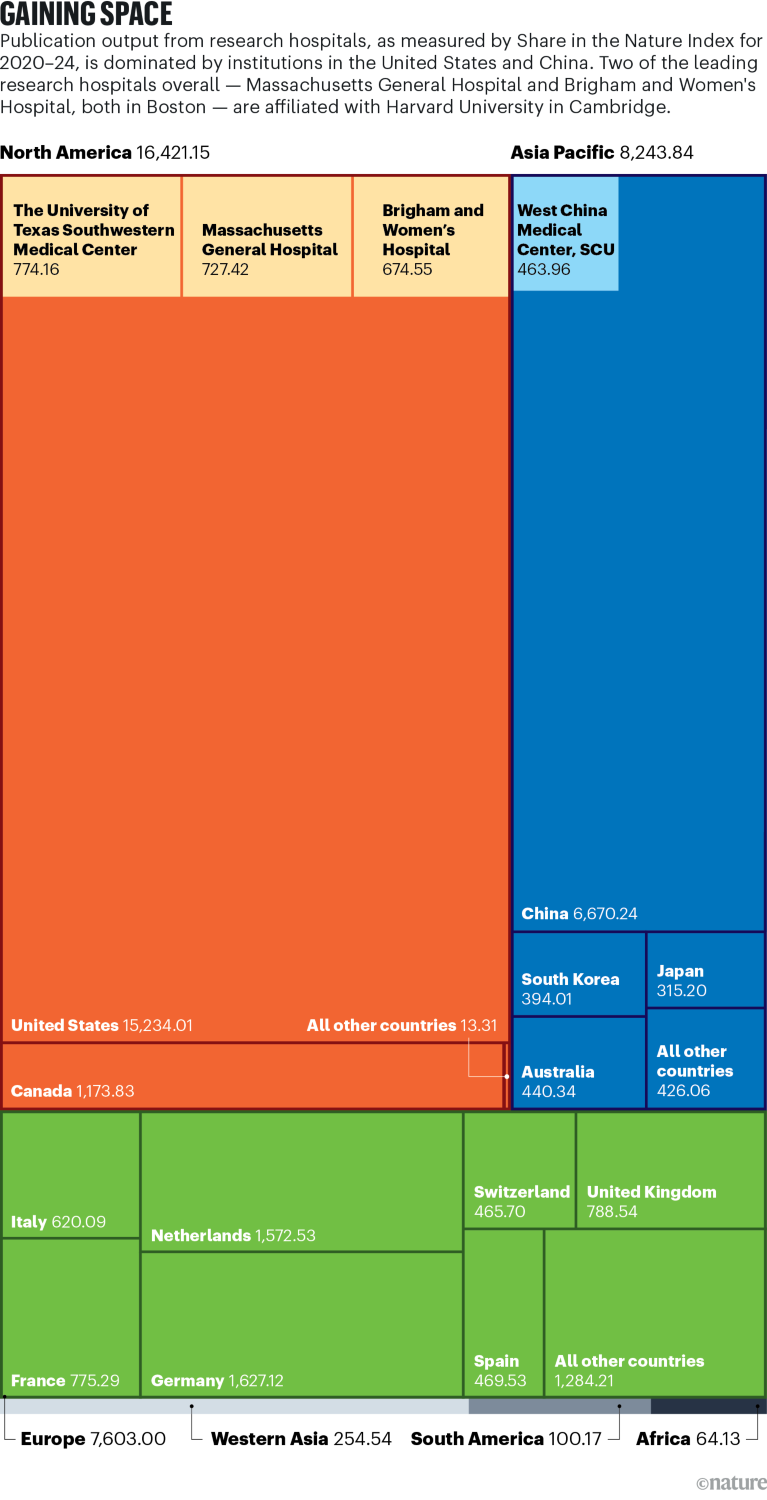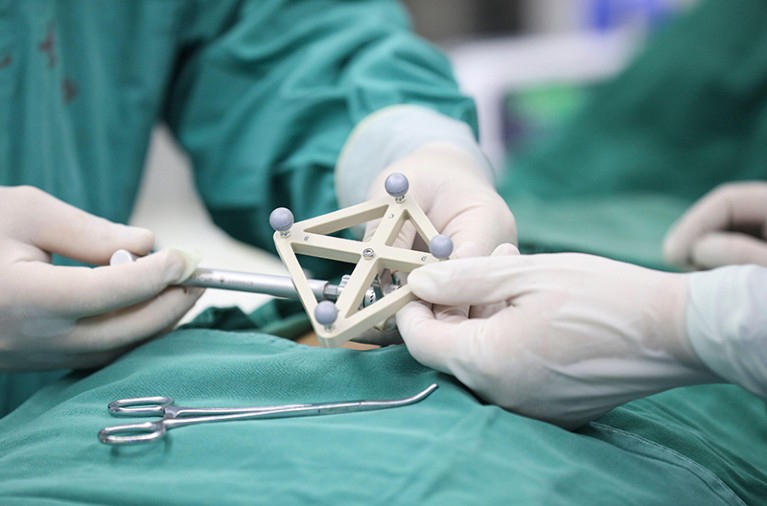Increasing evidence suggests that the geographical centre of medical research might be moving, as the amount and quality of research produced by China’s research hospitals rises, and the United States’ grip on the sector loosens.
China increased its investment in science by more than 3,800% between 1996 and 2023, says Bilal Demirel, who studies science and innovation at the Rathenau Institute in The Hague, the Netherlands, and is now coming close to matching what the United States spends. With China currently increasing its annual R&D budget by 7% — while US funding looks set to fall under President Donald Trump — there is every chance China will lead on research investment in the coming years.
Thanks to this growing government support, some of China’s research hospitals are rapidly moving up the Nature Index rankings. But questions remain about the quality of research in the Chinese health-care sector, with some of its hospitals also topping global lists for retracted papers — and it is not yet clear how effective efforts to rein in the problem will be.
Hospitals on the up
“Chinese hospitals used to be quite weak in research, but that is changing rapidly,” says Yi Rao, director of the IDG/McGovern Institute for Brain Research at Peking University.
Rao says the trend is driven by an increase in the number of physicians who have had good training in rigorous research, more encouragement and support from the government for selected hospitals to carry out research, and an increase in collaboration between biomedical scientists and clinical scientists.
Nature Index 2025 Research hospitals
“Past experiences in the West have shown clearly, and China is learning quickly, that research in hospitals is integral for innovating new treatments and for validating good treatments,” says Rao.
Demirel’s data show that medical research is growing rapidly in the country. In 2003, about 10% of China’s research publications indexed in the Web of Science database were in medical fields. By 2023, that had grown to almost 20%. “They are really going hard on medical sciences,” he says.
Hospitals in China now make a significant contribution to the research output published in Nature Index journals. Of the leading 200 research hospitals in the world, ranked by Share, more than one-quarter — 51 in total — are in China, second only to the United States with 69. Germany lies at third with 20. The country’s top performer overall is West China Medical Center in Chengdu, home to the medical school of Sichuan University. It is ranked ninth among the world’s leading 200 research hospitals, based on research published from 2020 to 2024, and has been rising steadily through the ranks for the past few years, up from 24th in 2019. China’s hospitals are rapidly increasing their output as well. Among the top 25 fastest-rising research hospitals globally, ranked by how much their adjusted Share increased between 2023 and 2024, 16 are in China.
Areas of strength
Chenkai Wu, who studies global health at Duke Kunshan University in Kunshan, China, says that in 2024, the Chinese government launched initiatives to promote four priorities in health research, linked to China’s specific strengths and needs. These are new and emerging diseases, building on lessons learned from the COVID-19 pandemic; cancer and cardiovascular disease — two priorities that are growing issues in an ageing population; and rare diseases, leveraging China’s huge population. “Rare diseases are of course rare, but considering the population of China, we still have a lot of cases,” says Wu.
The initiatives are currently seeking input from the scientific community on specific research questions and its total funding has not yet been announced, says Wu, but he expects it to be worth hundreds of millions of yuan over a few years.

Source: Nature Index
Chinese researchers are also making strides in the field of global population health, says Wu. That is partly a legacy of China’s long-standing practice of providing medical services to developing countries throughout Asia and Africa, as part of its international aid programme.
“The government sent many teams overseas to provide medical aid, but until recently it didn’t involve a clear research component,” he says.
In 2013, the China Consortium of Universities for Global Health was launched by 10 leading universities in public health to build research capacity in the field, and it has since grown to 29 members. Wu and his colleagues carried out a bibliometric analysis of publications by the original 10 members between 2014 and 2020 (C. Wu et al. Glob. Health Res. Policy. 8, 10; 2023). They found that the number of publications in the field of global health that included data from outside China has steadily increased over that time, from just 10 in 2014 to 58 in 2020.
The most-studied research topic by far was chronic non-communicable diseases, totalling more publications than the next three most common topics combined. That reflects China’s “epidemiological shift” in recent years, says Wu, as the country has become better at dealing with infectious diseases while chronic illnesses become more common in the ageing population.
“Over 90% of deaths in China now are due to chronic illnesses, not infectious disease,” says Wu. “So they are the national priority for public health.” Child and maternal health, neurological disorders and infectious disease were also common topics.
But Wu also found that relatively few of the studies, just 16%, involved primary data collection — most were secondary analyses of existing data sets. Of the primary studies, most had study populations in Asia and Africa. Several involved studying malaria in Myanmar and its neighbouring regions in China, whereas the African studies tended to focus on child and maternal health.
There has been a surge in interest in China in building new large data sets that can support this kind of research, with the government investing a great deal of money over the past five years, says Wu. But Chinese scientists are now facing issues that are familiar to their colleagues in the West — these data sets can be expensive and challenging to maintain over the long term. “Funding agencies are very interested in building them, but less interested in maintaining them,” says Wu.
China has also now surpassed the United States in the number of ongoing clinical trials, according to an analysis (E. H. Lee et al. J. Clin. Epidemiol. 183, 111791; 2025) co-authored by John Ioannidis, an epidemiologist at Stanford University in California. China took the lead in 2019 and has maintained that lead in the years since. In 2023, China was home to 16,612 registered trials, compared with 9,100 for the United States.
Cancer, cardiovascular disease and metabolic diseases were prominent fields of study, but the trials cover the full gamut of medical research. “China is working on practically every disease, they’re not lagging behind in any area,” says Ioannidis.

Surgery takes place at a hospital in Huai’an using an orthopaedic surgical robot. Credit: CFOTO/Sipa USA/Alamy
Although one of the biggest issues facing sponsors of trials is increasing costs, the per-patient cost is lower in China, and is not rising as it is in the United States and elsewhere. This potentially offers new outsourcing and partnership opportunities for international sponsors, Revati Tatake, a researcher at London-based analysis firm GlobalData, told a clinical-trials industry conference in San Francisco in February.
Currently, however, China is involved in relatively few international trials conducted across multiple sites. Most of its trials are single-centre studies conducted only in China — with 70% run by sponsor companies based in the country.
“That doesn’t mean they’re not trustworthy, but they are less likely to be the pivotal trials that change the health-care landscape internationally,” says Ioannidis. “At the very top, China is not challenging the US just yet.”
These shifts in research output towards China are likely to accelerate in the coming years, as the Trump administration’s cuts to science agencies such as the US National Institutes of Health (NIH) begin to bite.
For example, many grants from the NIH have been abruptly cancelled for political reasons. The future of the agency also looks bleak — the Trump administration is proposing that the NIH’s budget be cut by almost 40% next fiscal year and its 27 institutes consolidated into just 8.
“It is a loss to the US, but also a loss to patients of the whole world,” says Rao. “Fortunately, the cut in the US coincides with some dramatic increases in Chinese support for science and medical research.”
Rao says that if the United States keeps cutting back on funding then China will eventually be able to pick up the slack. “It will take a while for China to pick up all that is cut by the US,” he says — perhaps 10 or 20 years — but if the cuts continued he would be “confident that China will surpass the current level of US support for medical research”.
Persistent problems
Despite the rise of China’s research hospitals in international rankings such as the Nature Index, some of the country’s medical institutions have a spotty reputation when it comes to research quality and integrity.
A Nature analysis found that Chinese hospitals and medical schools dominate the list of institutions that had the greatest proportion of their research output retracted between 2014 and 2024 (see Nature 638, 596–599; 2025). Retractions can represent attempts to correct unintentional errors, but they can also be a result of fraud and misconduct. The top three spots in the Nature analysis, and seven of the top ten, were all taken by hospitals in China, although there was no overlap with institutions topping the Nature Index.